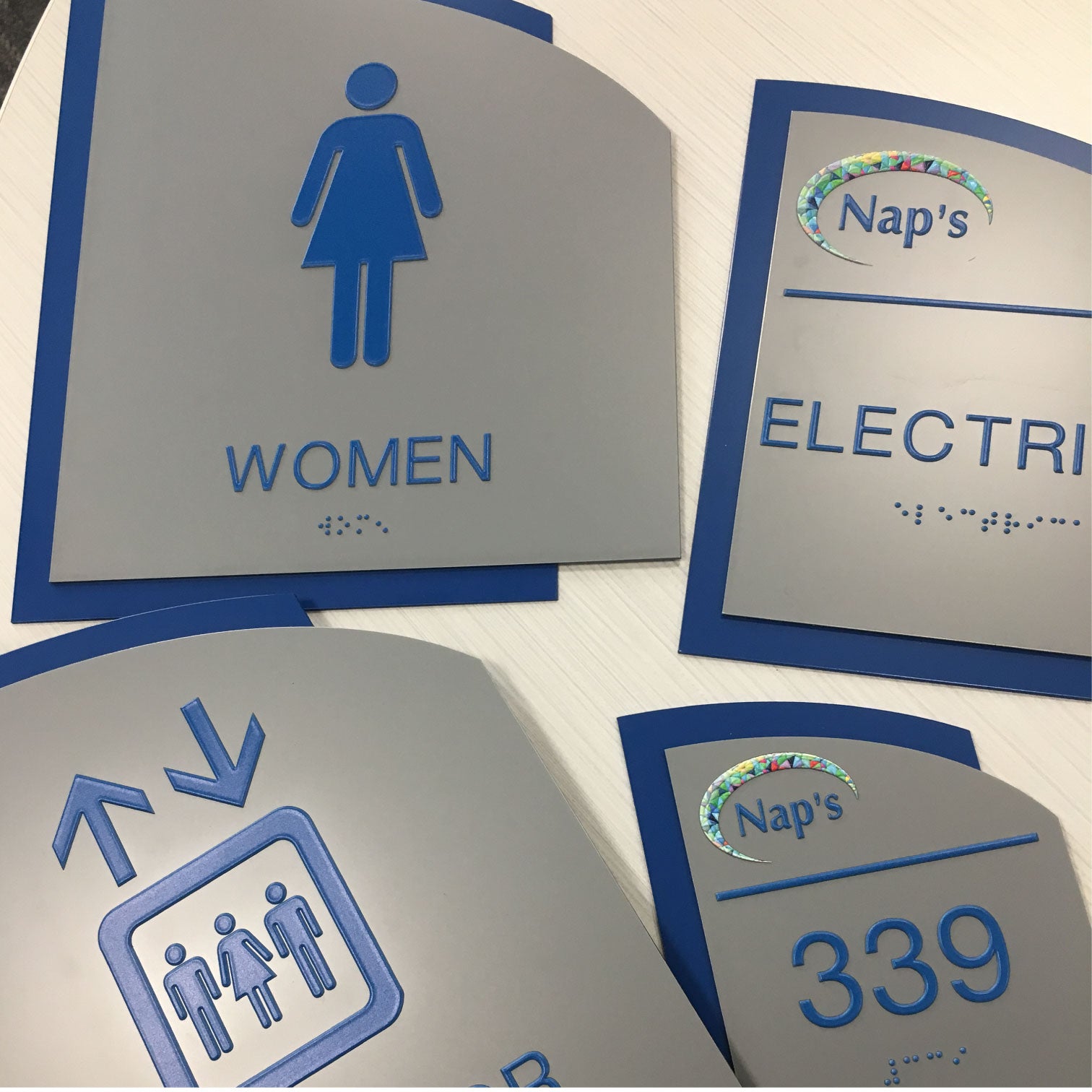Discover the Importance of ADA Signs in Public Spaces
Exploring the Key Attributes of ADA Indicators for Boosted Access
In the world of ease of access, ADA indicators serve as quiet yet powerful allies, making sure that spaces are accessible and inclusive for individuals with disabilities. By incorporating Braille and tactile aspects, these indications break obstacles for the aesthetically impaired, while high-contrast shade schemes and readable fonts cater to varied visual demands.
Relevance of ADA Compliance
Ensuring conformity with the Americans with Disabilities Act (ADA) is important for fostering inclusivity and equivalent accessibility in public spaces and offices. The ADA, passed in 1990, mandates that all public centers, employers, and transport solutions fit individuals with handicaps, ensuring they delight in the very same rights and possibilities as others. Conformity with ADA criteria not just fulfills legal responsibilities however additionally boosts an organization's credibility by showing its dedication to variety and inclusivity.
Among the key aspects of ADA conformity is the application of accessible signs. ADA indicators are created to make certain that people with handicaps can easily browse via structures and rooms. These indicators have to stick to details standards pertaining to dimension, font style, color contrast, and placement to guarantee visibility and readability for all. Properly implemented ADA signs aids eliminate barriers that people with disabilities frequently experience, thus promoting their freedom and self-confidence (ADA Signs).
Furthermore, adhering to ADA regulations can mitigate the risk of lawful consequences and possible penalties. Organizations that fail to follow ADA standards may deal with charges or suits, which can be both financially challenging and harmful to their public photo. Therefore, ADA compliance is important to fostering an equitable environment for everybody.
Braille and Tactile Components
The consolidation of Braille and responsive aspects right into ADA signs embodies the concepts of availability and inclusivity. It is generally positioned below the equivalent text on signage to make certain that individuals can access the details without aesthetic assistance.
Tactile aspects prolong beyond Braille and include increased symbols and personalities. These parts are made to be noticeable by touch, enabling individuals to identify room numbers, washrooms, departures, and other vital areas. The ADA sets particular guidelines concerning the size, spacing, and positioning of these responsive components to enhance readability and make sure uniformity throughout different atmospheres.

High-Contrast Color Pattern
High-contrast color design play a critical role in boosting the presence and readability of ADA signage for people with aesthetic impairments. These systems are necessary as they make the most of the difference in light reflectance between message and history, making sure that indicators are easily discernible, also from a range. The Americans with Disabilities Act (ADA) mandates making use of particular shade contrasts to suit those with restricted vision, making it an essential element of compliance.
The effectiveness of high-contrast colors depends on their capacity to attract attention in various lights conditions, consisting of dimly lit settings and areas with glare. Commonly, dark text on a light history or light text on a dark history is utilized to accomplish optimum comparison. As an example, black message check these guys out on a white or yellow background gives a stark visual distinction that assists in quick recognition and understanding.

Legible Fonts and Text Size
When thinking about the layout of ADA signage, the choice of readable typefaces and ideal text size can not be overstated. These aspects are critical for ensuring that signs come to people with aesthetic problems. The Americans with Disabilities Act (ADA) mandates that typefaces have to be sans-serif and not italic, oblique, script, very ornamental, or of unusual type. These demands assist guarantee that the text is easily readable from a distance which the personalities are distinct to varied audiences.
According to ADA standards, the minimal text elevation ought to be 5/8 inch, and it should raise proportionally with checking out distance. Uniformity in text dimension contributes to a natural visual experience, aiding people in navigating environments efficiently.
In addition, spacing between lines and letters is important to clarity. Sufficient spacing prevents personalities from showing up crowded, boosting readability. By sticking to these requirements, designers can significantly boost access, guaranteeing that signage offers its intended purpose for all individuals, regardless of their visual capacities.
Efficient Positioning Strategies
Strategic positioning of ADA signs is crucial for taking full advantage of availability and making certain conformity with lawful requirements. ADA guidelines stipulate that signs should be mounted at an elevation in between 48 to 60 inches from the ground to guarantee they are within the line of sight for both standing and seated individuals.
Furthermore, signs must be positioned surrounding to the latch side of doors to allow very easy identification prior to entrance. Uniformity in sign positioning throughout a center improves predictability, decreasing complication and boosting overall customer experience.

Final Thought
ADA signs play an essential function in promoting ease of access by incorporating functions that address the demands of people with disabilities. Including Braille and responsive aspects ensures important info comes to site the aesthetically damaged, while high-contrast color pattern and legible sans-serif typefaces enhance exposure throughout numerous lights conditions. Effective my website placement techniques, such as proper placing elevations and strategic locations, additionally promote navigating. These components collectively foster an inclusive atmosphere, emphasizing the relevance of ADA compliance in guaranteeing equal accessibility for all.
In the world of ease of access, ADA indications serve as quiet yet effective allies, making sure that areas are comprehensive and accessible for individuals with impairments. The ADA, enacted in 1990, mandates that all public centers, companies, and transportation services suit people with specials needs, guaranteeing they delight in the exact same rights and possibilities as others. ADA Signs. ADA indicators are created to make sure that people with specials needs can quickly navigate via spaces and structures. ADA standards state that signs need to be placed at an elevation between 48 to 60 inches from the ground to guarantee they are within the line of view for both standing and seated individuals.ADA indicators play a crucial function in promoting ease of access by incorporating attributes that attend to the needs of people with impairments